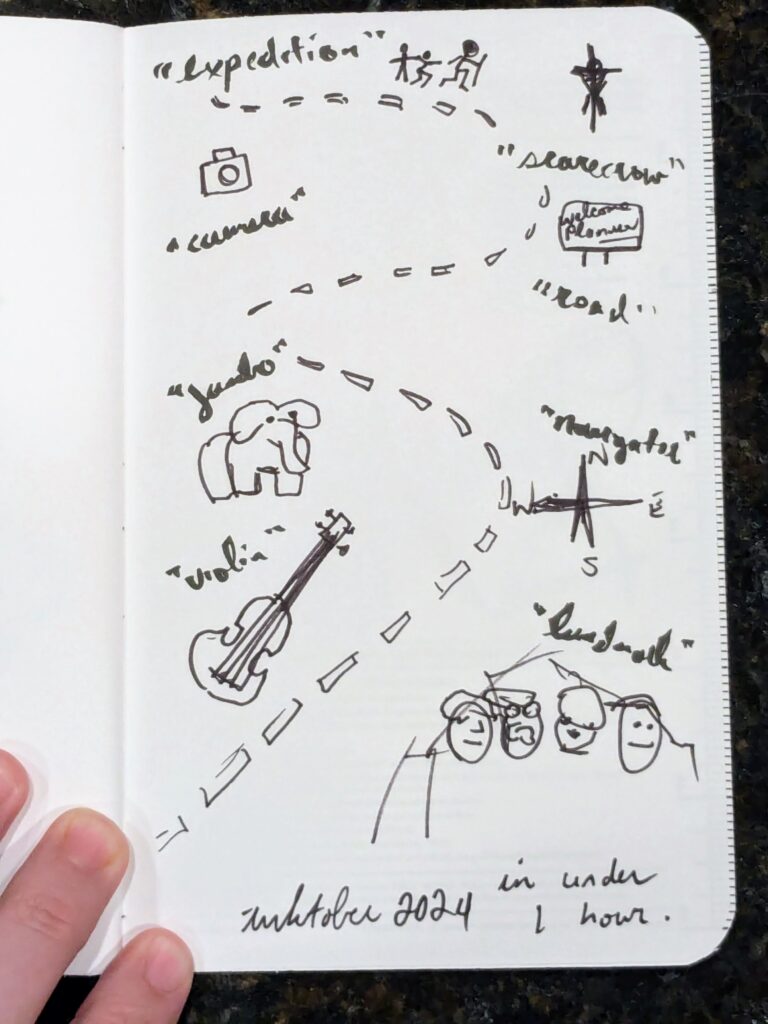Participating in the Inktober challenge is often celebrated as a way to build consistency, push creativity, and explore new ideas. Founded by artist Jake Parker, Inktober encourages artists to create one ink drawing each day for a month, following a list of prompts. I embarked on this artistic process to dive into structured creativity. However, as my experiment unfolded—rushing through multiple prompts in a matter of days—it became clear that prompts and deadlines might not align with my creative rhythm.
The Journey: From “Backpack” to a Frantic Finish
I kicked things off with the “Backpack” prompt, giving it my full attention. I spent time working through the details, shading, and really enjoying the process. This piece was exactly what I had hoped Inktober would be—a chance to slow down and explore an idea deeply.
Feeling good about the start, I moved on to the next prompt: “Discover.” But this is where things changed. Impatience crept in, and I found myself trying to pick up the pace. Instead of carefully developing each drawing, I tried to sprint through the prompts—reminiscent of my Botober showdown with AI, racing the clock to see how much I could complete.
This new rhythm had its own momentum. Prompts like “Boots” and “Camp” were tackled faster, with less detail, but still with a sense of playful exploration. I kept moving, but as I ran out of blank pages, I found myself improvising—compressing multiple ideas onto a single composite spread. What started as a careful exercise soon morphed into a chaotic, high-speed adventure against time.
Creative Frustration: When Prompts Don’t Flow
One of the toughest moments came with the “Exotic” prompt. No matter how I approached it, I couldn’t find a satisfying concept. What I ended up with was a strange squiggle that vaguely resembled the Tiger King—a visual disaster born out of creative burnout. This moment crystallized something important: structured prompts, while great for some, don’t always align with how I prefer to work.
Lessons from the Inktober Sprint
- Rapid Prototyping Sparks Creativity
Though the structured nature of Inktober felt frustrating at times, it did teach me to embrace imperfection and experiment freely. The limited time pushed me to trust my instincts and be okay with rough, unpolished sketches. There’s a certain freedom in knowing not every piece has to be perfect. - Letting Go of Structure Sparks Joy
As I sped through the prompts, I realized I’m more drawn to exploring individual ideas on my own terms, rather than sticking to a rigid prompt list. Abstract or personal projects give me more room to breathe creatively than a strict daily schedule. - Creativity Shouldn’t Feel Like a Chore
By the time I reached the final stretch, the challenge had become more about completing prompts than enjoying the process. The experience felt more like ticking off a checklist than engaging in meaningful creation. That’s not how I want to approach my art going forward.
Favorite Outputs from My Inktober Experiment
Despite some sketches’ rushed nature, I’m proud of some moments. Here are a few highlights:

“Backpack”: This was my favorite piece. I spent the most time on it, allowing myself to get lost in shading and form.

“Boots”: A simple, satisfying drawing. It gave me a chance to explore lines and shading without overcomplicating things.

“Camp”: An abstract interpretation of a campfire—more playful than precise, but it captured the moment.

Composite Page: When I ran out of blank pages, I merged multiple prompts onto one spread. The result is chaotic, but it reflects the spontaneity that emerged during the challenge.
Finding My Own Artistic Rhythm
Inktober allowed me to reflect on my creative process. While I appreciate the structure and discipline the challenge promotes, I realized it doesn’t quite align with how I like to create. Moving forward, I plan to focus more on personal projects—exploring abstract concepts and individual ideas that interest me, rather than following a prompt list.
For anyone thinking of taking on a creative challenge like Inktober, my advice is simple: try it, but adapt it to fit your own rhythm. There’s no one right way to create, and sometimes the best art comes when you let go of the rules.
